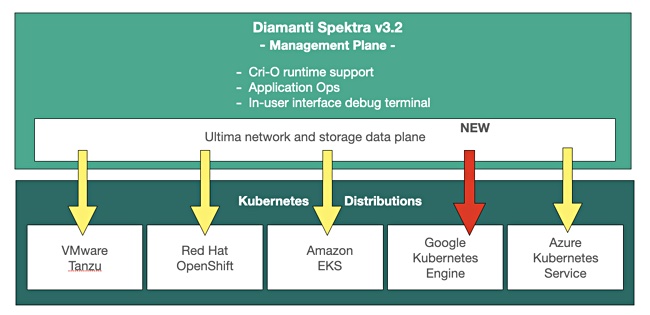Interview: Diamanti started out as a hyperconverged infrastructure appliance vendor but then switched to supplying Kubernetes lifecycle management software that runs on its Spektra all-flash and bare-metal HCI system as well as other systems.
We spoke to CPO/CTO and EVP Engineering Jaganathan Jeyapaul about some of the issues, including customers being more “thoughtful in their Kubernetes choices”, and more.

The proposition of Diamanti’s Spektra environment is that businesses need a dedicated environment, on-premises or in the public cloud, within which to run Kubernetes and that it is not just another system app to run inside a virtual machine or general server.
Jeyapaul told us Diamanti’s storage software is purpose built to provide high performance and security for cloud native applications running on Kubernetes, adding that through the use of storage accelerator cards, it achieves “about 1 million IOPS per Kubernetes node.”
Blocks & Files: Kubernetes is becoming table stakes for any storage supplier, either on-premises or in the public cloud. What are your thoughts around Kubernetes and its management being a feature and not a product?
JJ: Kubernetes has become the cloud’s default operating system. Provisioning & managing Kubernetes clusters is not a standalone product anymore, rather it is an expected feature within any higher-level cloud product that manages a group of cloud applications and services running flavors of Kubernetes across multi-clouds and hybrid clouds (the service mesh). Diamanti’s control plane and orchestration product has the core ability to monitor, manage and administer Kubernetes across multi-clouds and hybrid-clouds through telemetry data intelligence.

Blocks & Files: Will Kubernetes become a cloud-native orchestration tool for IT workloads in general and then also IT infrastructure in general? What are the pros and cons of this?
JJ: Heavy-duty, data-intensive IT workloads (homegrown stateful apps, 3rd party software ex: Analytics) are typically containerized already, and hence run well within Kubernetes. These heavy-duty IT workloads must rely upon a scale-out architecture to achieve performance at scale. Kubernetes serves as an excellent orchestration tool for the scaled-out IT workload nodes. IT infrastructure similarly benefits through Kubernetes adoption for configuration management, deployment, and lifecycle management of infrastructure components.
However, if enterprises aren’t thoughtful in their Kubernetes choices, they could lock themselves inadvertently into different flavors of Kubernetes, which would reduce the portability of their workloads. Diamanti is a great equalizer in that our Kubernetes-based orchestration platform levels the playing field by providing accelerated performance and security while being 100 percent portable between on-premise and cloud clusters.
Blocks & Files: Does Kubernetes have any relevance to composable infrastructure, and if so, what do you think it is?
JJ: Kubernetes enhances a well-designed composable infrastructure and by sharing similar design principles, Kubernetes-based composable infrastructure provides a complete elastic, low-cost (no over-provisioning) and durable infrastructure for data-intensive, scaled-out stateful applications at scale.
Blocks & Files: How is access to Kubernetes secured?
JJ: Kubernetes distributions are generally very secure (specialist vendors like Diamanti thoroughly scan their distros and are certified). However, there are vulnerabilities in the ways a Kubernetes cluster is deployed & administered that require careful investigation. Kubernetes clusters must follow security best practices & standards for RBAC, secret protection, infrastructure as code, container security and end-point protection.
Blocks & Files: What would you say about the idea that Kubernetes is too low-level for mass enterprise use and an abstraction layer with automated functions needs to be erected over it?
JJ: Kubernetes has been adopted by about 90 percent of enterprises already. It is seen as the default cloud OS and platform, and its plugin-based architecture allows for building customized infrastructures to meet all enterprise workload needs. Kubernetes itself must be treated somewhat as a low-level function and a well-designed control plane abstraction for the management of Kubernetes nodes, plugins, and IT workloads is needed in most cases, e.g., Diamanti Spektra.
Blocks & Files: What will the Kubernetes world and ecosystem look like in 5 years’ time?
JJ: Kubernetes will become ubiquitous and will serve as the portable “runtime” for micro apps/services for the serverless, edge and ambient computing use cases. It will be to micro cloud workloads what Java is to on-premises legacy applications (write once, run anywhere, any cloud, any device).








